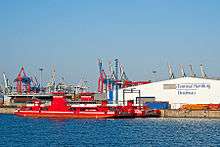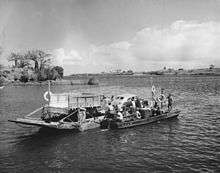Likoni Ferry
|
| |
| Locale | Mombasa, Kenya |
|---|---|
| Waterway | Kilindini Harbour |
| Transit type | Pedestrian and vehicular ferry |
| Operator | Kenya Ferry Services |
| System length | 500 m (1,600 ft) |
| No. of vessels |
MV Harambee MV Pwani MV Kilindini MV Mvita MV Nyayo MV Likoni MV Kwale MV Jambo |
| No. of terminals | Mombasa and Likoni |
The Likoni Ferry is a boat service across the Kilindini Harbour, serving both the island city of Mombasa and the Kenyan mainland town of Likoni. Two - four double-ended ferries alternate across the harbour, carrying both road and foot traffic. The ferries are operated by the Kenya Ferry Services (KFS), and is the only remaining ferry service by KFS. The Likoni ferry started operating in 1937. Passenger services are free while vehicles, tuktuks and motorcycles have to pay a ferry toll.
The Mombasa side terminal of the Likoni line is located at the southern end of the Mombasa Island. The distance of the line is about 500 metres.
Service
Apart from the main Likoni line, there is a passenger-only peak hour service between Mtongwe and Mombasa island next to Bandari College. It crosses the Kilindini Creek few kilometres west of the Kilindini line. The service was halted pending repairs of the ramp that was damaged.


There are five operating ferries. MV Mvita and MV Pwani were bought in 1969 and 1974, respectively. MV Nyayo, MV Harambee, and MV Kilindini were bought second hand in 1990. KFS is in process to buy two new ferries, but the order was repeatedly delayed.[1] The two arrived in June 2010. They have been christened as MV Kwale and MV Likoni.
Three of the operating ferries,MV Harambee, MV Nyayo and MV Kilindini have been deregistered from Lloyd's Register (an international maritime classification society), being not seaworthy.[2] As at May 2011, at least MV Nyayo was in use as the relief ferry, now painted blue.
The Dongo Kundu bypass has been planned to ease the congested ferry. The road would run from Shika Adabu (between Likoni and Diani) to Miritini (west of Mombasa Island, along the Mombasa-Nairobi highway). The road would be 12–24 km long depending on whether bridges would be built to cross the Likoni creek.[3] Currently the shortest route by road from Likoni to Mombasa Island is through the Kwale town, 30 kilometres southwest of Mombasa.[4]
A direct bridge or tunnel from Likoni to Mombasa Island had also been proposed, but the high cost of building them has made these options unlikely.[5]
The U.S. Dept of State in its travel advisory on Kenya updated on Feb 27, 2018 has cautioned the use of the Likoni ferry in Mombasa due to safety concerns.
Mtongwe Disaster
On April 29, 1994, the MV Mtongwe ferry bound for the mainland capsized just 40 meters from port, killing 272 of the 400 people on board.[6] Following the disaster, it was reported that the capacity of the ship was 300. As of 2005, KFS had compensated 81 families a total of KSh 36,902,472 ($486,840 USD).[7]
Charges
The KFS does not charge people. However motor vehicles are charged
Motorbike pays 40/=; Saloon car 90/=; Mini bus 450/= and Bus 880/=. [8]
References
- ↑ Daily Nation, January 8, 2009: New ferries delay raises eyebrows
- ↑ Daily Nation, March 7, 2010: New ferries no magic wand, say experts
- ↑ The Standard, January 28, 2010: A bypass might solve the ferry debacle
- ↑ Kenya - The Rough Guide Map
- ↑ Daily Nation, March 7, 2010: State sitting on grand proposals over ferry problems
- ↑ Daily Nation, Wednesday Magazine, November 19, 2003: The restless ghosts of Mtongwe
- ↑ Kenyan ferry firm compensates tragedy victims — Ferrynews
- ↑ "KFS toll charges". Retrieved 22 February 2017.